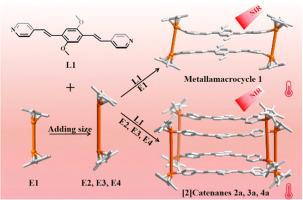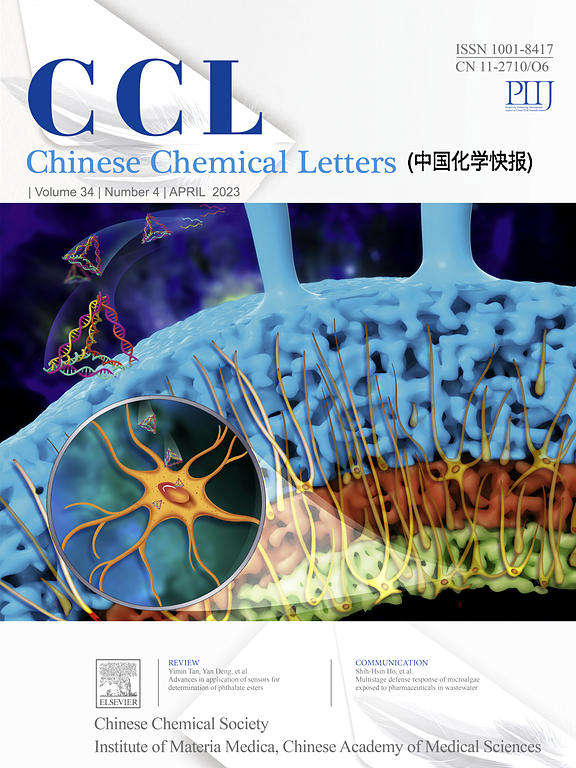Controllable self-assembly and photothermal conversion of metalla[2]catenanes induced by synergistic effect of free radicals and stacking interactions
IF 8.9
1区 化学
Q1 CHEMISTRY, MULTIDISCIPLINARY
引用次数: 0
Abstract
The self-assembly and photothermal application studies of interlocked compounds has been attracting increasing attention during the last decades. Nevertheless, the synthesis of a series of interlocked topologies possessing similar structural characteristic and clarifying their photothermal performance law remains a challenge. Herein, we introduce a new dipyridinyl ligand L1 featuring two methoxy groups, which act as electron-donating species and provide electrons to the central benzene ring, resulting in an enhanced electron rich effect. Previous research indicates that this feature significantly contributes to forming π-stacking interactions. Furthermore, four half-sandwich rhodium-based building blocks exhibiting different metal-to-metal distances and conjugated effect were selected and used to combine with L1 for the synthesis of [2]catenanes and metallamacrocycles for studying the influence of half-sandwich building blocks on photothermal conversion performance under the same accumulation effect. Three new metalla[2]catenanes and one metallamacrocycle have been obtained in high yields and their structure has been unambiguously confirmed by single crystal X-ray diffraction analysis, NMR spectroscopy, and ESI-TOF-MS. In addition, dynamic structural transformation between [2]catenanes and the corresponding metallamacrocycles has been observed through concentration changes and polar solvent induced effect. Photothermal conversion abilities of the isolated complexes were studied and we observed that [2]catenane 3a displayed significant temperature changes (from 25.8 °C to 50.3 °C) under laser irradiation of 1.5 W/cm2, thereby reaching a photothermal conversion efficiency of 40.42 %. Recorded EPR data indicates that the synergistic cooperation of the free radical effect at the building unit and the stacking effect of [2]catenanes most likely generated photothermal conversion.

自由基协同效应和堆叠相互作用诱导金属[2]链烷的可控自组装和光热转化
近几十年来,互锁化合物的自组装和光热应用研究越来越受到人们的关注。然而,合成一系列具有相似结构特征的互锁拓扑结构并阐明其光热性能规律仍然是一个挑战。本文引入了一种新的二吡啶基配体L1,该配体具有两个甲氧基,作为给电子物质,向中心苯环提供电子,从而增强了富电子效应。已有研究表明,这一特征对π-堆积相互作用的形成有重要作用。选择4种具有不同金属间距离和共轭效应的半夹心铑基构筑块,与L1结合合成[2]链烷和金属大环,研究在相同积累效应下,半夹心构筑块对光热转化性能的影响。通过单晶x射线衍射分析、核磁共振波谱分析和ESI-TOF-MS等手段对其结构进行了明确的证实,得到了三个新的金属[2]链烷和一个金属大环。此外,通过浓度变化和极性溶剂诱导效应,观察到[2]链烷与相应的金属大环之间的动态结构转变。研究了分离的配合物的光热转化能力,发现在1.5 W/cm2的激光照射下,[2]catenane 3a的温度变化显著(从25.8 °C到50.3 °C),光热转化效率达到40.42 %。记录的EPR数据表明,构建单元自由基效应和[2]链烷的叠加效应的协同作用最有可能产生光热转化。
本文章由计算机程序翻译,如有差异,请以英文原文为准。
求助全文
约1分钟内获得全文
求助全文
来源期刊

Chinese Chemical Letters
化学-化学综合
CiteScore
14.10
自引率
15.40%
发文量
8969
审稿时长
1.6 months
期刊介绍:
Chinese Chemical Letters (CCL) (ISSN 1001-8417) was founded in July 1990. The journal publishes preliminary accounts in the whole field of chemistry, including inorganic chemistry, organic chemistry, analytical chemistry, physical chemistry, polymer chemistry, applied chemistry, etc.Chinese Chemical Letters does not accept articles previously published or scheduled to be published. To verify originality, your article may be checked by the originality detection service CrossCheck.
 求助内容:
求助内容: 应助结果提醒方式:
应助结果提醒方式:


